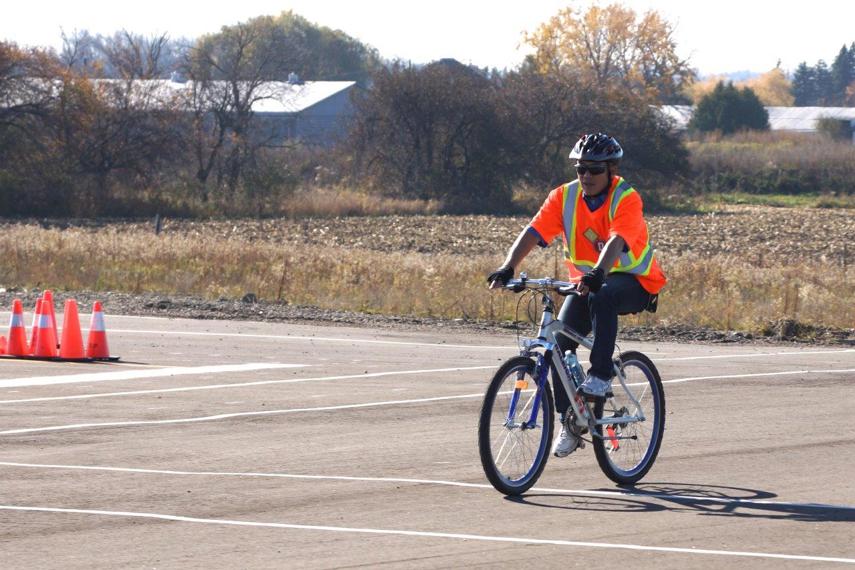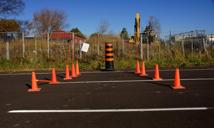On November 4, Steven Bochenek attended the Young Drivers Solution to Distracted Driving Event and hasn’t slept well since. Appropriately — yet without irony —attendees were encouraged to confirm their participation by Hallowe’en. From there, suffice it to say, you are not safe.
Statistics can be a bugger. For instance, exactly when distracted driving recently surpassed DUI and speeding as the #1 way to kill and die on Ontario roads depends on how you read the stats. Interpreting the numbers and definitions is like navigating the 401 the Monday morning after the daylight saving shift. It’s terrifying regardless of where you end up.
Worse, last year half of (a statistically valid sample of) the next generation of Ontario’s drivers openly admitted to texting and driving, a state of such Zen distraction, you’re 23 times more likely to collide with something while doing it.
Texting and driving sounds specific enough but distraction has become a catchall statisticians’ term for over 40 different behaviours. So shouldn’t distracted driving have overtaken speed and DUI decades ago? You could also argue that drunkenness itself is a fairly convincing state of distraction. (Ever tried shrinking your to-do list after a box of wide-mouth Colt 45 malt liquor? It doesn’t happen often; just ask my wife.)
We all know that stats lie because people lie — especially people reporting their own culpability to police and insurance companies compiling statistics. Who would admit to being so distracted that, say, he drove his truck off with the dumpster-bed in the upright position — at least, without video proof? Speaking of which, is the concerned citizen shooting that video honestly checking and re-checking mirrors, blind spots and his own speed versus the posted limit while documenting the sins of others?
The point remains: distraction is both dangerous and epidemic.
So if you’re reading this from the road, please put down the phone, park someplace safe (like an insane asylum) to learn about a recent Young Drivers of Canada (YD) presentation on distracted driving. (I’ve barely slept since, for fear some idiot, watching a skiing squirrel on YouTube, drives across our lawn, through the picture window and upstairs into our bedroom, angrily waving the finger at us for implying disapproval of his driving with our shocked expressions, before smashing through the back window into the lane.) The YD event entailed a horrifying Powerpoint presentation, sandwiched between two driving practicums.
 Young Drivers keeps a compound with an intersection that starts and goes nowhere but takes drivers places they rarely think about.
Young Drivers keeps a compound with an intersection that starts and goes nowhere but takes drivers places they rarely think about.
So we began with an actual drive at the Advanced Driving Centre (ADC), YD’s private compound for traffic simulations, just northeast of the GTA, about a click from the farm where they actually hosted the event. The ADV is a pristine intersection of paved road that stops after about 50 metres in 3 directions, looking like a section from an unfinished ‘50s subdivision where kids named Ace and Spike would do donuts at night in their dad’s Chevy.
Speaking of statistical accuracy, the event actually began the second I got in a company Prius C with two YD officials. The first sat in the front with his clipboard (CP) authoritatively on his lap — it must be intimidating to be a teenager taking driving lessons — and directed me through the practicum. The other, lurking in the backseat, silently filmed me throughout from two feet away, like some creepy uncle (CU) at your seventh birthday party.
CP directed me to drive out immediately and south to the ADC. Instead, I checked and adjusted the Prius’s mirrors and seat, only then pulling out onto the road, where I lowered the sunshade to block the low autumn sun.
“Can you adjust the fan? It’s hot in here,” CP said.
Stupid me, I did — after searching the panel for the controls. Strike one. Sure I could lie and say that having reviewed the Prius C a couple of years ago that I knew exactly where to look but this drive was an important learning experience. Besides, CU caught it all on video.
When we arrived at the compound, CP directed me to the start of a little circuit, where he zeroed out a stopwatch — ooh, you didn’t say it’s a race!! — then blathered something about the importance of checking all points but I’d stopped listening, mentally preparing myself to beat all the others who’d been through the course earlier in the day.
 “He came outta nowhere.” “The sun was in my eyes.” “Normally, I never text and drive.”
“He came outta nowhere.” “The sun was in my eyes.” “Normally, I never text and drive.”
Yes, something about timing the suite of exercises on this little course gave it an excitingly real feeling. How odd to call the mundane and quotidian exciting, I was thinking to myself while awaiting the starter’s pistol.
“Distraction, blah, blah,” CP droned, “everyone is affected, blah, blah. OK?” Yes, okay! “First, you’ll make a right . . . And go!” He clicked the stopwatch.
And we’re off! Foot’s right down because I want to win and, besides, way out here at this manufactured corner in some private driving-simulation compound in the country, there’s nothing to hit.
Except for that cyclist!
Whoops! . . . where’d he come from?
Strike two, Steve! Noisily blasting a sport-whistle like a banshee on crack or a Toronto courier, the bike “appeared from nowhere.” That’s what we distracted drivers all say: it wasn’t my fault; I didn’t see him; the sun was in my eyes; it was dark and raining; it was the wind with el Niño; it was the knishes and cannoli YD fed us. Anyway, the bike suddenly zipped to my inside where and when I was turning.
The truth is I hadn’t seen him. So, now I was rattled. These guys were good. We’ll return to the compound later because things only got worse. How much? If you were to extend the baseball analogy, I didn’t just strike out, CP pitched a perfect game.
There are 4 types of distraction: visual, manual and cognitive.
Paying attention? Good! YD listed three but I’m adding the fourth form of distraction: a combination of any of the others. During our sit-and-listen session, other YD officials gleefully shared horrifying truths, reiterating the one from earlier. If texting while driving, you’re 23 times more likely to crash. According my calculator that’s two thousand three hundred percent more dangerous!
When you perform tasks that require more than one of the above or, heaven forbid, all three distractors — like texting — you’re asking for it and are more dangerous than a hungover pitbull with a gun.
The unnerving revelations blossomed from there. For instance, “most drivers are inattentive about half the time,” Charles Shrybman, YD’s Senior Regional Trainer, is happy to be quoted.
Here’s the problem. Most people believe incongruously that texting while driving is dangerous and that they’re better drivers than others. Ergo, most people believe “It’s okay for me to text while driving but not you.”
No revelation alarmed me like the eye experiment.
A miraculous if mushy ballet of rods and cones, your photoreceptors sadly are NOT cameras. Shrybman demonstrated that your eye does not always see what’s in front, with a pixelated graphic, like some pirated early version of PacMan. On a black background, three yellow dots formed a would-be a scalene triangle around a centered green dot. This bright unit sat fixed while a faded and blue graph jerkily rotated clockwise behind it.
“Focus on the dot and count the number of times any of the yellow ones disappear from your periphery in the next 15 seconds, starting now.” At first, all held still. This is easy. Then one disappeared — whoops — and popped back into existence. At times two vanished briefly and for a half second all three were gone. I wondered if we were to count the multiple disappearances as individuals or combinations. It didn’t matter because “None of them disappeared at all.”
 “The sun was in my eyes.” “He came outta nowhere.” “Normally, I never text and drive.” Everyone is a great driver. Just ask them.
“The sun was in my eyes.” “He came outta nowhere.” “Normally, I never text and drive.” Everyone is a great driver. Just ask them.
“We’re blind and blinder to our own blindness,” said Shrybman.
That sounds like stoned folk singer lyrics, but it’s true. (I didn’t ask Shrybman whether he inhaled in college, but if I taught young Torontonians to drive for a living, I’d be a raging alcoholic.) The lesson is in the makeup of the eye.
You should continually be looking forward in traffic but with regular scanning breaks onto the periphery and into the mirrors. After just two seconds of focusing on something — that’s only one Mississippi, two Mississippi — your peripheral vision starts to narrow. It’s how we were designed.
Next, they demonstrated how multi-tasking is a myth†, though I already knew this one. Sure, you can walk and talk and chew gum at the same time, but you cannot simultaneously perform two actions that require your attention. As a simple demo, they timed me while first I wrote down the numbers 1 to 40 — 18 seconds — then again while I wrote the words “distracted driving” (13 seconds).
Then they did it again while I rewrote both in combination, interrupting each digit with a letter like so: 1 d 2 i 3 s 4 t . . .
Dyslexic as fcuk, my brain froze before 8 seconds.
Mac users would’ve marveled the spinning beach ball above my head. Of course, we all know that you rarely need your FULL attention when driving. Well, except that, really, you kind of do — as that spontaneously generating cyclist at ADC had so three-dimensionally demonstrated minutes earlier. Speaking of which, that’s enough scary science for now. Let’s drive back to the facility for the second crack at their course of distractions.
You’d expect me to have improved but I was quite rattled by this point. First, upon re-entering the Prius I stupidly remarked (ask CU for video footage) “No need to check the mirrors; I was the last one in the car!” Remember what your grade 10 geography teacher said about making assumptions? The remark came back to embarrass me minutes later. We were repeating the same course as before. So I was ready for the cyclist this time. Except that I wasn’t because — of course — they had messed with the mirrors during the PPT session. Reprise the screeching whistle and jerking halt!
These YD instructors weren’t just good, they were evil.
Next, the instructions they gave me included placing a phone call to another YD official — yes, I pulled over before making the call — who instructed me to (while performing tricky parking maneuvers between cones) begin counting backwards in threes from 752. What?! Dyslexic as fkcu, I immediately began counting 6s upwards from 527, while crushing perfectly good orange cones so thoroughly they couldn’t even play defence for the Leafs.
Time to change the rules. I stopped counting and driving. Took a deep breath.
 Reverse into this spot without scraping cone, while counting backwards from 752 by 3s.
Reverse into this spot without scraping cone, while counting backwards from 752 by 3s.
How much did these guys rattle me? The first draft of this story had the exact phone number they’d asked me to call and you would’ve been encouraged to relate my regards.
I took two more breaths and, thereon, stopped following any of CP’s instructions that contravened rules of the road or logic. Which was one of the lessons.
Then I slowly completed the rest of the complicated little course, focused, getting almost none of the maneuvers wrong. The interesting result was that, this drive on the compound, less distracted and taking my time, I finished only 4 seconds later than the first pass at the practicum. The greatest lesson was nakedly apparent.
Functionally, you save no time driving dangerously distracted!
Please forward this article to everyone you know who thinks they don’t need to read it.

